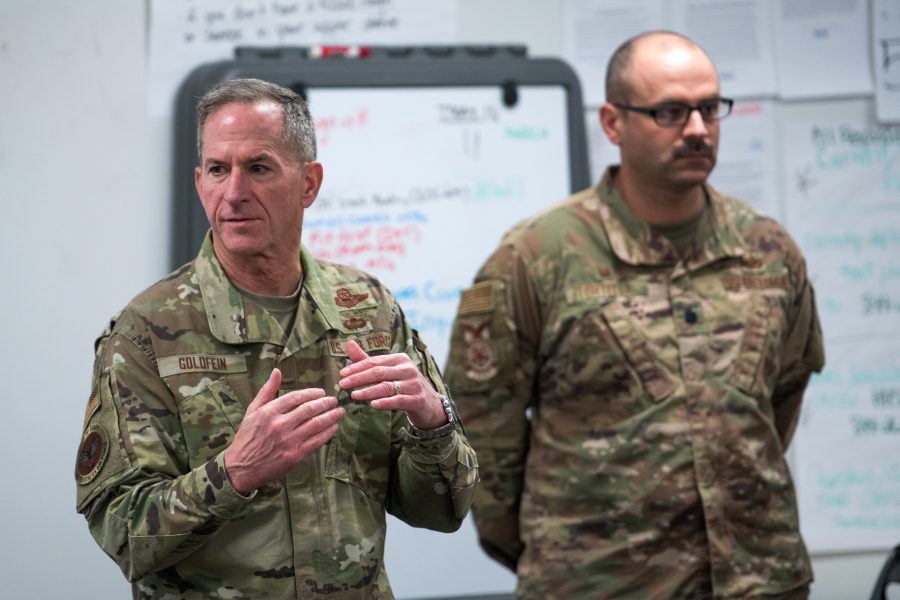The Air Force is preparing to set a new operating rhythm under coronavirus restrictions, which Chief of Staff Gen. David Goldfein sees continuing for at least a year.
“What we’re looking at now is a new reset—1 June—I call the ‘new abnormal’: Living and operating with a cyclical virus until we get a vaccine,” Goldfein told defense reporters by telecon, April 22. “All the projections are no vaccine for upwards of a year, so that means we’ve got to refine our ability to survive and operate.”
The reset will lay out a path to continue the missions from which USAF will get “no relief,” such as nuclear deterrence and air mobility, and “bring back the missions we’ve slowed down so we can get back to some sense of new normalcy in an abnormal world.” These include the training pipeline, he said, noting that basic military training is operating at about 50 percent of its pre-pandemic capacity.
Until a vaccine is available, “We’re going to be living with this virus, and the potential for it to come back in some cyclical way is likely,” Goldfein said. The “good news,” is that the “ability to survive and operate … is part of our DNA,” and the pandemic is an opportunity to refresh that training, he added. The Air Force has long known how to function in chemical, biological, and radiological environments, he said, and the COVID-19 crisis simply means USAF will “go back to our roots.”
Lockheed Martin has said the coronavirus will slow down the F-35 program, and Boeing shut down production in its Washington-state facilities for several weeks, but Goldfein said “right now” USAF is not seeing significant impacts to the industrial base, where contractors can’t get the parts they need.
He’s working with other air chiefs on ways to collaborate to “keep the industrial base alive” and maybe create shared systems that will lower prices and increase readiness for all. This is particularly important for “the subs, the Tier 2 and Tier 3 suppliers.”
He’s also in close talks with other F-35 countries, such as Italy, Canada, Japan, and South Korea, to see if “we can collaborate on this. It might be that we can make better use of our money collectively, as opposed to individually,” trying to tide over lower-tier contractors “that cannot be replaced.”
However, he said the Pentagon is not aiming to bring some F-35 support contracts back to the U.S., as it did with work being done in Turkey. Goldfein said he still sees the defense industrial base as shrinking.
Pentagon acquisition and sustainment chief Ellen Lord said earlier this week there would be about a three-month lag in deliveries of major systems, and Goldfein said that tracks with what the Air Force expects.
The programs “we’re watching the closest” are the F-35, KC-46, B-21 and T-7A trainer, Goldfein noted.
“Three months is not surprising at all, given what industry is dealing with in trying to keep their lines open,” he said. “The production facilities where workers have to gather in close proximity are the ones having the most challenges. Production facilities where people have been able to spread out are the ones that have been able to keep up and running without as many delays.”
The Air Force and Space Force also are keeping a close eye on space programs. “I’m not hearing anything that tells me programs are in a critical state or at risk of cancellation,” Goldfein said. Air Force acquisition chief Will Roper has been good at hooking up vulnerable small businesses with outside capital because “they don’t have time” or the resiliency imparted by having large amounts of cash on hand to “ride out” the pandemic, Goldfein said.
The pandemic has caused the Air Force to streamline and improve its ability to communicate, Goldfein said, noting that a meeting he had the day before with “25-30 people” comprising all his Major Command commanders and other senior officers was thrown together quickly, whereas in the pre-pandemic world “it might take weeks to get that kind of gathering together.”
The rush to graduate the Air Force Academy class early required the service to “step up” its distance-learning game and professional military education, Goldfein said. “There are some things where I hope we never go back to the previous era, in terms of … how we’re delivering content … and how we’re using some of the new tools.”
He also said U.S. Northern Command chief Gen. Terrence O’Shaughnessy is the “thought leader” on improving command and control, having developed direct lines to “all the medical centers, all the key support hubs,” and has partnered with Apple and Google on search engine technology, “so he’s probably got the highest-fidelity data” of anyone in the response chain.
His own lack of travel has allowed Goldfein the time to step up the number of calls he’s making with foreign air chiefs and industry leaders, which he described as “an opportunity to water the garden, keep relationships fresh.”
Editor’s Note: This story was updated on April 23 at 2:33 p.m. EDT to correct the date the teleconference was held.

